Wireless Networking and Communication Assignment: Technologies
VerifiedAdded on 2020/03/04
|5
|987
|51
Homework Assignment
AI Summary
This assignment solution delves into the realm of wireless networking and communication, commencing with a detailed examination of diverse antenna types, including Yagi, horn, cellular, and helical antennas. It then provides a comparative analysis of CDMA and FDMA technologies, highlighting their operational differences and applications. The assignment further explores advanced wireless technologies, focusing on Wireless Gigabit (WiGig), its operational characteristics at 60 GHz, adaptive beamforming, security aspects, and applications in various domains. The solution also includes a discussion of the advantages, disadvantages, and future prospects of WiGig, offering a comprehensive overview of the subject matter.
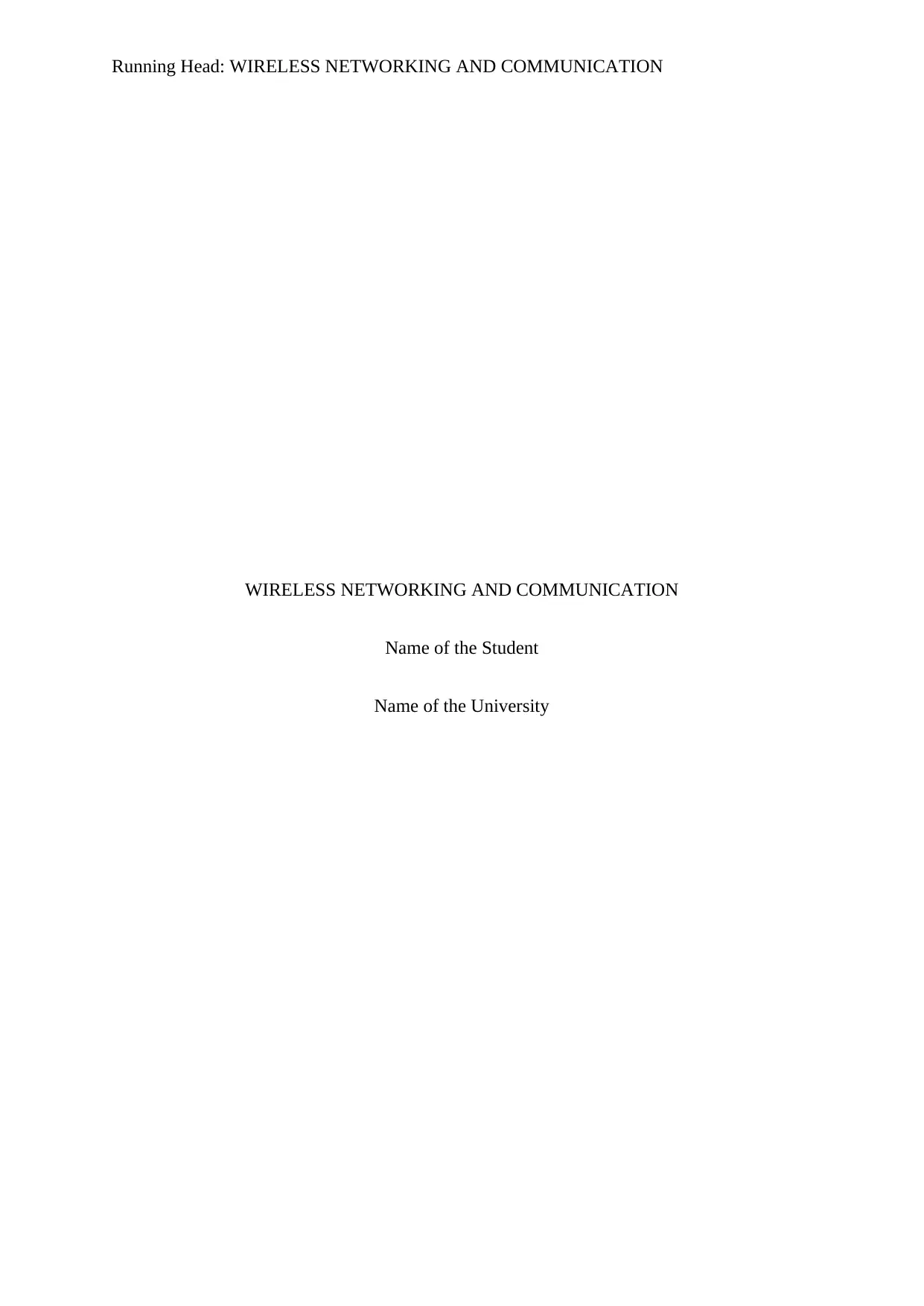
Running Head: WIRELESS NETWORKING AND COMMUNICATION
WIRELESS NETWORKING AND COMMUNICATION
Name of the Student
Name of the University
WIRELESS NETWORKING AND COMMUNICATION
Name of the Student
Name of the University
Paraphrase This Document
Need a fresh take? Get an instant paraphrase of this document with our AI Paraphraser
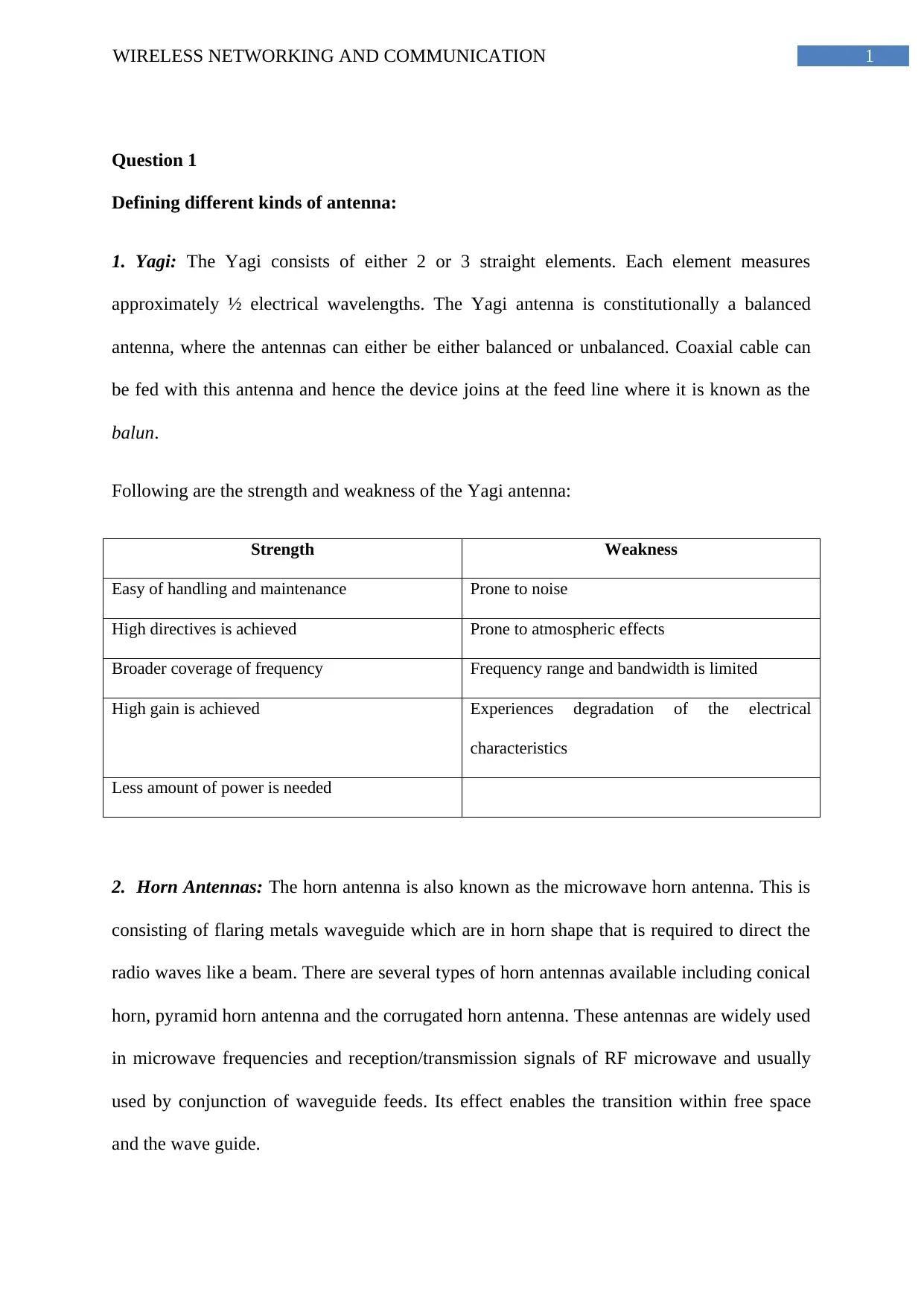
1WIRELESS NETWORKING AND COMMUNICATION
Question 1
Defining different kinds of antenna:
1. Yagi: The Yagi consists of either 2 or 3 straight elements. Each element measures
approximately ½ electrical wavelengths. The Yagi antenna is constitutionally a balanced
antenna, where the antennas can either be either balanced or unbalanced. Coaxial cable can
be fed with this antenna and hence the device joins at the feed line where it is known as the
balun.
Following are the strength and weakness of the Yagi antenna:
Strength Weakness
Easy of handling and maintenance Prone to noise
High directives is achieved Prone to atmospheric effects
Broader coverage of frequency Frequency range and bandwidth is limited
High gain is achieved Experiences degradation of the electrical
characteristics
Less amount of power is needed
2. Horn Antennas: The horn antenna is also known as the microwave horn antenna. This is
consisting of flaring metals waveguide which are in horn shape that is required to direct the
radio waves like a beam. There are several types of horn antennas available including conical
horn, pyramid horn antenna and the corrugated horn antenna. These antennas are widely used
in microwave frequencies and reception/transmission signals of RF microwave and usually
used by conjunction of waveguide feeds. Its effect enables the transition within free space
and the wave guide.
Question 1
Defining different kinds of antenna:
1. Yagi: The Yagi consists of either 2 or 3 straight elements. Each element measures
approximately ½ electrical wavelengths. The Yagi antenna is constitutionally a balanced
antenna, where the antennas can either be either balanced or unbalanced. Coaxial cable can
be fed with this antenna and hence the device joins at the feed line where it is known as the
balun.
Following are the strength and weakness of the Yagi antenna:
Strength Weakness
Easy of handling and maintenance Prone to noise
High directives is achieved Prone to atmospheric effects
Broader coverage of frequency Frequency range and bandwidth is limited
High gain is achieved Experiences degradation of the electrical
characteristics
Less amount of power is needed
2. Horn Antennas: The horn antenna is also known as the microwave horn antenna. This is
consisting of flaring metals waveguide which are in horn shape that is required to direct the
radio waves like a beam. There are several types of horn antennas available including conical
horn, pyramid horn antenna and the corrugated horn antenna. These antennas are widely used
in microwave frequencies and reception/transmission signals of RF microwave and usually
used by conjunction of waveguide feeds. Its effect enables the transition within free space
and the wave guide.
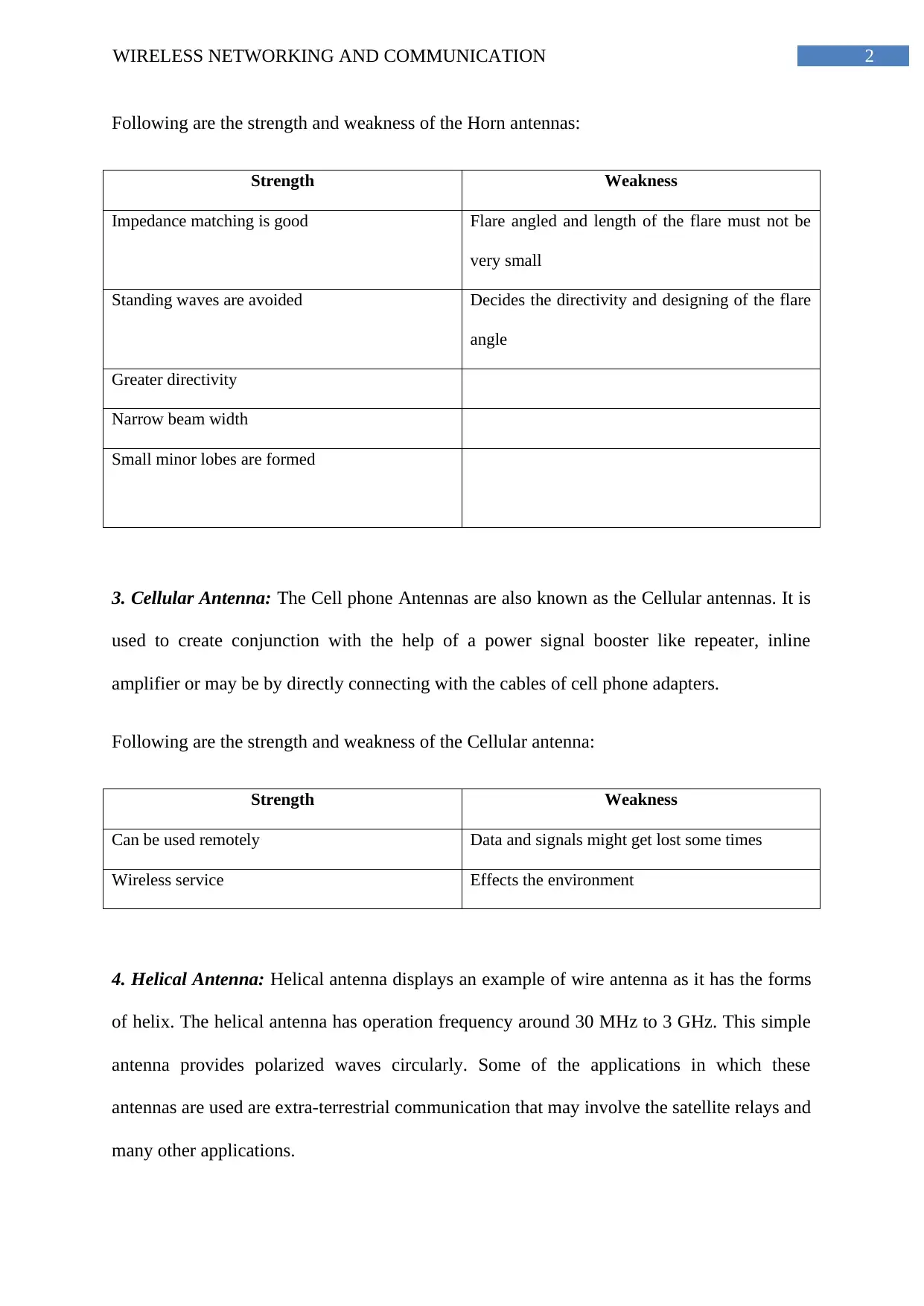
2WIRELESS NETWORKING AND COMMUNICATION
Following are the strength and weakness of the Horn antennas:
Strength Weakness
Impedance matching is good Flare angled and length of the flare must not be
very small
Standing waves are avoided Decides the directivity and designing of the flare
angle
Greater directivity
Narrow beam width
Small minor lobes are formed
3. Cellular Antenna: The Cell phone Antennas are also known as the Cellular antennas. It is
used to create conjunction with the help of a power signal booster like repeater, inline
amplifier or may be by directly connecting with the cables of cell phone adapters.
Following are the strength and weakness of the Cellular antenna:
Strength Weakness
Can be used remotely Data and signals might get lost some times
Wireless service Effects the environment
4. Helical Antenna: Helical antenna displays an example of wire antenna as it has the forms
of helix. The helical antenna has operation frequency around 30 MHz to 3 GHz. This simple
antenna provides polarized waves circularly. Some of the applications in which these
antennas are used are extra-terrestrial communication that may involve the satellite relays and
many other applications.
Following are the strength and weakness of the Horn antennas:
Strength Weakness
Impedance matching is good Flare angled and length of the flare must not be
very small
Standing waves are avoided Decides the directivity and designing of the flare
angle
Greater directivity
Narrow beam width
Small minor lobes are formed
3. Cellular Antenna: The Cell phone Antennas are also known as the Cellular antennas. It is
used to create conjunction with the help of a power signal booster like repeater, inline
amplifier or may be by directly connecting with the cables of cell phone adapters.
Following are the strength and weakness of the Cellular antenna:
Strength Weakness
Can be used remotely Data and signals might get lost some times
Wireless service Effects the environment
4. Helical Antenna: Helical antenna displays an example of wire antenna as it has the forms
of helix. The helical antenna has operation frequency around 30 MHz to 3 GHz. This simple
antenna provides polarized waves circularly. Some of the applications in which these
antennas are used are extra-terrestrial communication that may involve the satellite relays and
many other applications.
⊘ This is a preview!⊘
Do you want full access?
Subscribe today to unlock all pages.

Trusted by 1+ million students worldwide
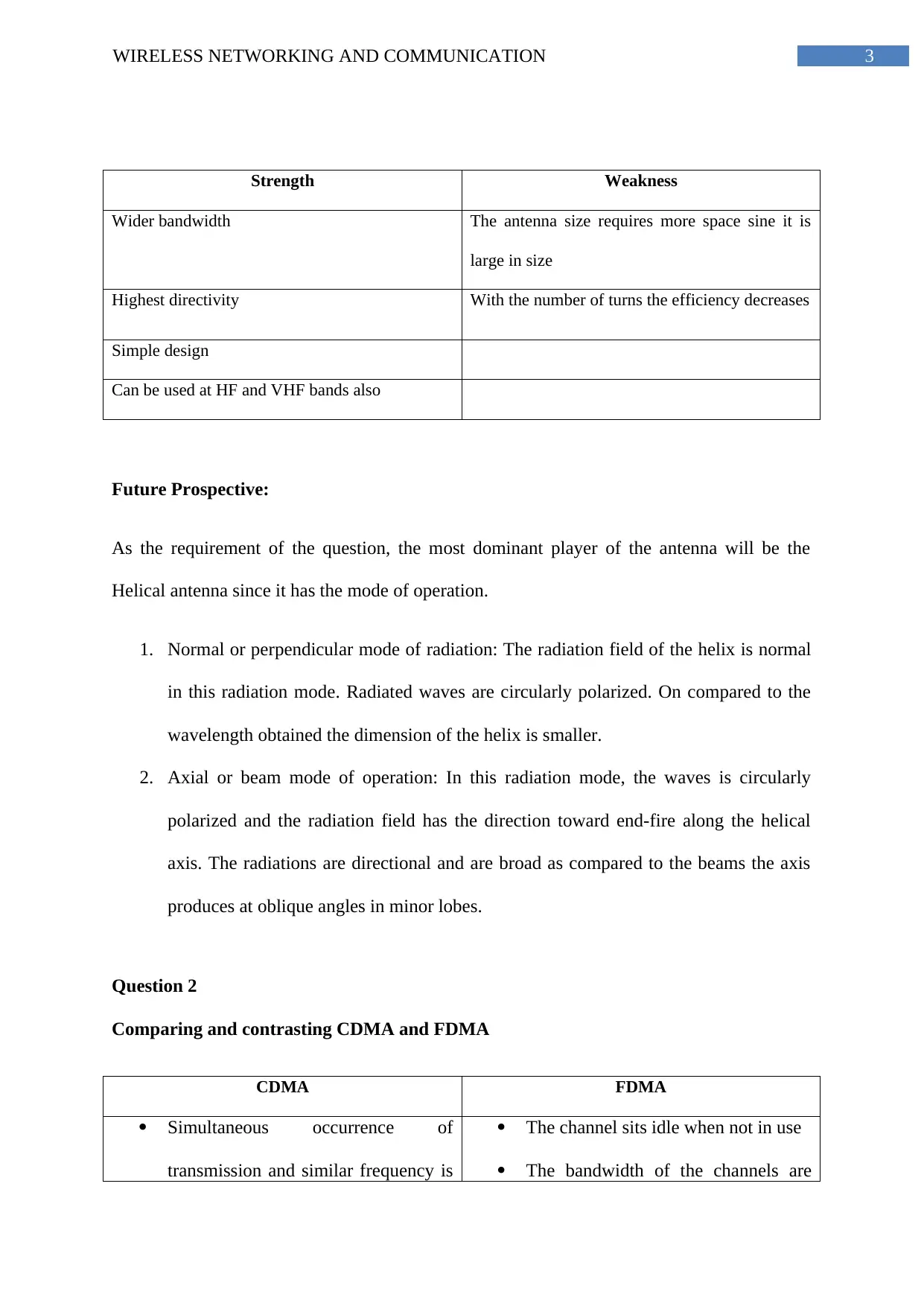
3WIRELESS NETWORKING AND COMMUNICATION
Strength Weakness
Wider bandwidth The antenna size requires more space sine it is
large in size
Highest directivity With the number of turns the efficiency decreases
Simple design
Can be used at HF and VHF bands also
Future Prospective:
As the requirement of the question, the most dominant player of the antenna will be the
Helical antenna since it has the mode of operation.
1. Normal or perpendicular mode of radiation: The radiation field of the helix is normal
in this radiation mode. Radiated waves are circularly polarized. On compared to the
wavelength obtained the dimension of the helix is smaller.
2. Axial or beam mode of operation: In this radiation mode, the waves is circularly
polarized and the radiation field has the direction toward end-fire along the helical
axis. The radiations are directional and are broad as compared to the beams the axis
produces at oblique angles in minor lobes.
Question 2
Comparing and contrasting CDMA and FDMA
CDMA FDMA
Simultaneous occurrence of
transmission and similar frequency is
The channel sits idle when not in use
The bandwidth of the channels are
Strength Weakness
Wider bandwidth The antenna size requires more space sine it is
large in size
Highest directivity With the number of turns the efficiency decreases
Simple design
Can be used at HF and VHF bands also
Future Prospective:
As the requirement of the question, the most dominant player of the antenna will be the
Helical antenna since it has the mode of operation.
1. Normal or perpendicular mode of radiation: The radiation field of the helix is normal
in this radiation mode. Radiated waves are circularly polarized. On compared to the
wavelength obtained the dimension of the helix is smaller.
2. Axial or beam mode of operation: In this radiation mode, the waves is circularly
polarized and the radiation field has the direction toward end-fire along the helical
axis. The radiations are directional and are broad as compared to the beams the axis
produces at oblique angles in minor lobes.
Question 2
Comparing and contrasting CDMA and FDMA
CDMA FDMA
Simultaneous occurrence of
transmission and similar frequency is
The channel sits idle when not in use
The bandwidth of the channels are
Paraphrase This Document
Need a fresh take? Get an instant paraphrase of this document with our AI Paraphraser
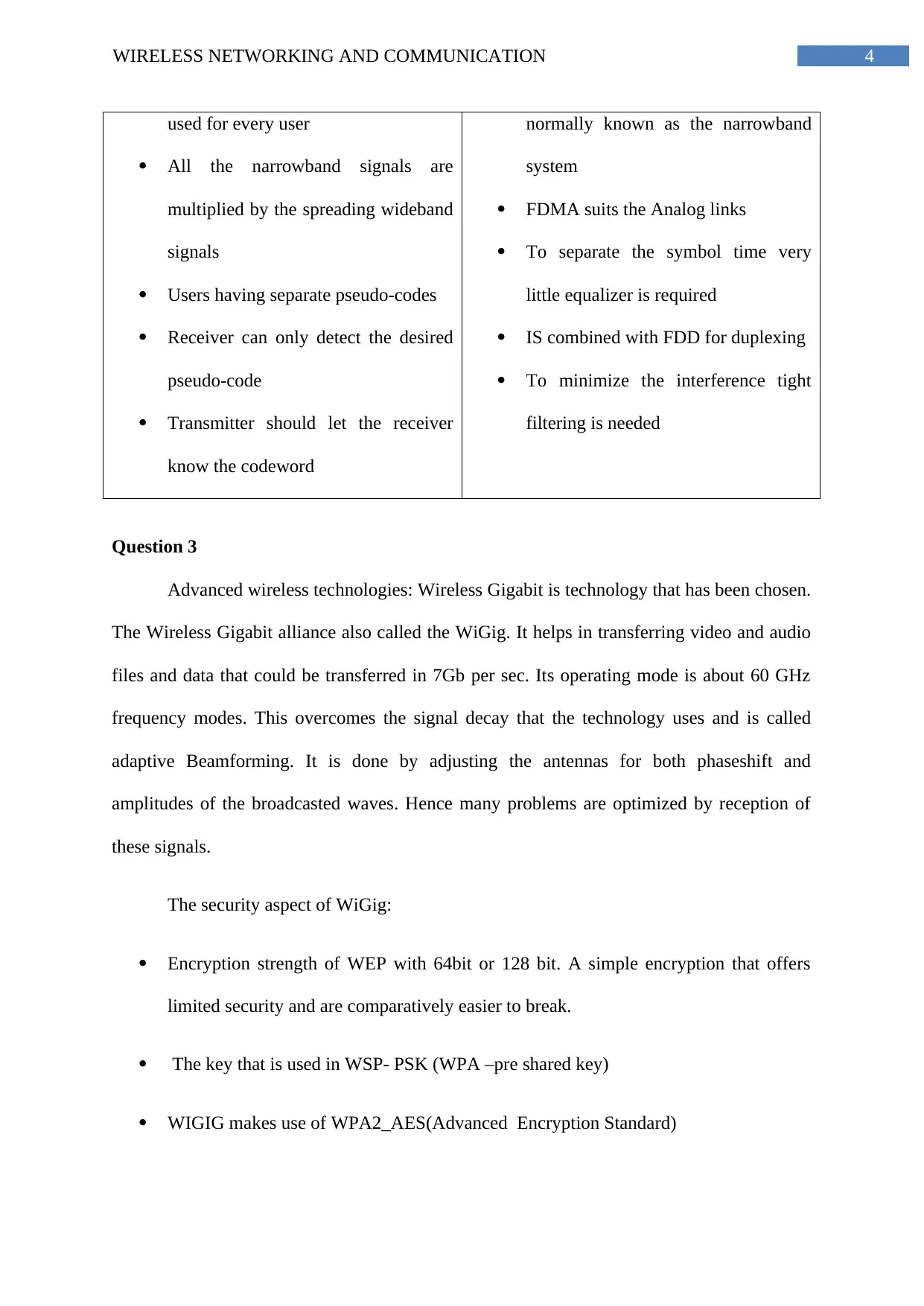
4WIRELESS NETWORKING AND COMMUNICATION
used for every user
All the narrowband signals are
multiplied by the spreading wideband
signals
Users having separate pseudo-codes
Receiver can only detect the desired
pseudo-code
Transmitter should let the receiver
know the codeword
normally known as the narrowband
system
FDMA suits the Analog links
To separate the symbol time very
little equalizer is required
IS combined with FDD for duplexing
To minimize the interference tight
filtering is needed
Question 3
Advanced wireless technologies: Wireless Gigabit is technology that has been chosen.
The Wireless Gigabit alliance also called the WiGig. It helps in transferring video and audio
files and data that could be transferred in 7Gb per sec. Its operating mode is about 60 GHz
frequency modes. This overcomes the signal decay that the technology uses and is called
adaptive Beamforming. It is done by adjusting the antennas for both phaseshift and
amplitudes of the broadcasted waves. Hence many problems are optimized by reception of
these signals.
The security aspect of WiGig:
Encryption strength of WEP with 64bit or 128 bit. A simple encryption that offers
limited security and are comparatively easier to break.
The key that is used in WSP- PSK (WPA –pre shared key)
WIGIG makes use of WPA2_AES(Advanced Encryption Standard)
used for every user
All the narrowband signals are
multiplied by the spreading wideband
signals
Users having separate pseudo-codes
Receiver can only detect the desired
pseudo-code
Transmitter should let the receiver
know the codeword
normally known as the narrowband
system
FDMA suits the Analog links
To separate the symbol time very
little equalizer is required
IS combined with FDD for duplexing
To minimize the interference tight
filtering is needed
Question 3
Advanced wireless technologies: Wireless Gigabit is technology that has been chosen.
The Wireless Gigabit alliance also called the WiGig. It helps in transferring video and audio
files and data that could be transferred in 7Gb per sec. Its operating mode is about 60 GHz
frequency modes. This overcomes the signal decay that the technology uses and is called
adaptive Beamforming. It is done by adjusting the antennas for both phaseshift and
amplitudes of the broadcasted waves. Hence many problems are optimized by reception of
these signals.
The security aspect of WiGig:
Encryption strength of WEP with 64bit or 128 bit. A simple encryption that offers
limited security and are comparatively easier to break.
The key that is used in WSP- PSK (WPA –pre shared key)
WIGIG makes use of WPA2_AES(Advanced Encryption Standard)
1 out of 5
Related Documents
Your All-in-One AI-Powered Toolkit for Academic Success.
+13062052269
info@desklib.com
Available 24*7 on WhatsApp / Email
![[object Object]](/_next/static/media/star-bottom.7253800d.svg)
Unlock your academic potential
Copyright © 2020–2025 A2Z Services. All Rights Reserved. Developed and managed by ZUCOL.





